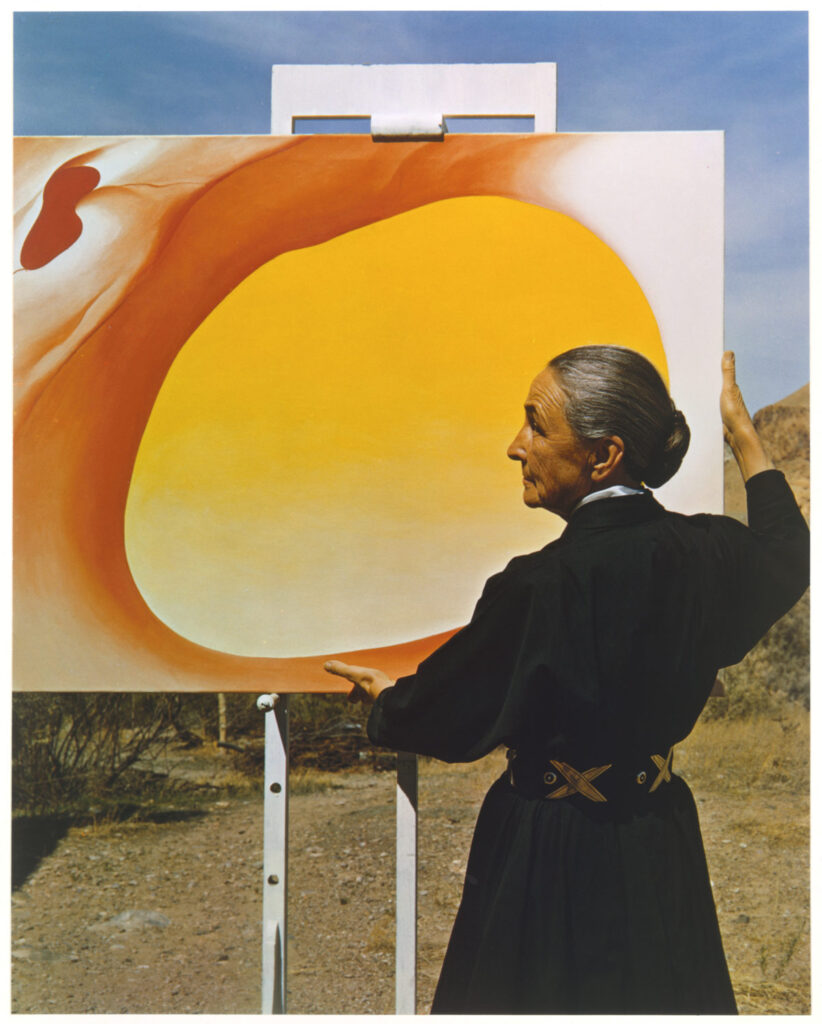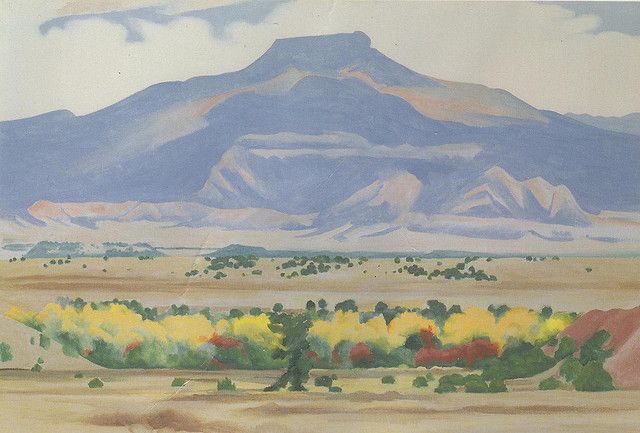

Needs no Introduction
Georgia O’Keeffe was an American artist, who was often referred to an the ‘Mother of American Modernism’. She is best known for her large paintings of flowers, skyscrapers and the landscapes of New Mexico.
Born on November 15, 1887, the second of seven children, Georgia Totto O’Keeffe grew up on a farm near Sun Prairie, Wisconsin. By the time she graduated from high school in 1905, O’Keeffe had determined to make her way as an artist. She studied at the Art Institute of Chicago and the Art Students League in New York, where she learned the techniques of traditional painting.
Georgia O’Keeffe, in her ability to see and marvel at the tiniest detail of a flower or the vastness of the southwestern landscape, drew us in as well. The more she cultivated her isolation, the more she attracted the rest of the world.





By working in extreme close-up in this and other pieces such as Dark Iris No I (1929), O’Keeffe frames floral anatomy as pure form. Few look at flowers, she noted, because “to see takes time”; her aim was to surprise the viewer into taking that time.
What is it that makes her legacy so powerful, even today?
People recognize flowers, bones, buildings. But something in her paintings also shows us how to see. We stroll on the beach or hike a footpath and barely notice a delicate seashell or the subtle shades of a pebble; we kick aside a worn shingle. Driving through the desert we shade our eyes from the sun, blink, and miss the lone skull, signifying a life long since gone. Georgia embraced all these things and more, brought them into focus and forced us to make their acquaintance. Then, she placed them in a context that stimulated our imagination.

THE METROPOLITAN MUSEUM OF ART, NEW YORK.
The remains of an elk’s skull hovering over the desert’s horizon, or the moon looking down on the hard line of a New York skyscraper briefly guide us into another world.

CARMEN THYSSEN-BORNEMISZA COLLECTION ON LOAN AT THE MUSEO THYSSEN-BORNEMISZA, MADRID
To this day, her work is as bright, fresh and moving as it was nearly 100 years ago. Why? Because, although the paintings, simple in their execution, hold a feeling of order, of being well thought out, a steadiness, yet a vehicle to help all of us see and examine the sensual delicacy of a flower, the starkness of a bleached skull and the electricity of a Western sunset.
The New Mexico Years
I n 1949, Georgia bid goodbye to the city that launched her career and settled permanently in New Mexico, dividing her time between Abiquiú in the winter and Ghost Ranch in the summer.

Although Georgia treasured her solitude, she was not above entertaining friends on holidays, as well as visitors who occasionally dropped in — although she often gave them a guesthouse in the complex for her convenience, not necessarily their privacy. Once they were gone, and she worked through a brief period of loneliness, she was once again happy to be by herself, often lying outside at night in the courtyard, surrounded by walls, and the nighttime sky for a roof.

In O’Keeffe’s New Mexican works play with echoes in organic and inorganic form. The cascades of wrinkled, torn and folded red sandstone in The Mountain, New Mexico (1931) and Black Mesa Landscape, New Mexico/Out Back of Marie’s II (1930) resemble vast piles of offal. And the avalanche of paintings she produced from 1936 to 1949 in ‘Black Place’ — the Bisti Badlands in Navajo territory — intently probe voids and masses in hills she compared to a “mile of elephants”.
To Her Critiques
She resented the sexual connotations people attached to her paintings, especially during the 1920’s when Freudian theories became a form of what today might be termed “pop psychology.” In Calla Lily with Roses, it has been observed that the lily with its stamen reflects Georgia’s uninhibited pre-occupation with sex, especially since the lily dominates the painting while the feminine rose hovers in the background. Eventually, on the advice of journalist, she adopted the philosophy that the reviews said more about the reviewer’s sexual proclivities than they did about her, but even years later, she threatened to stop painting if people continued their obsession with connecting Freudian premises to her work.
She also took issue with the “woman artist” label attached to her work. To be sure, there were other female painters at the time, but none of Georgia’s stature. Pre-twentieth century convictions prevailed: that a woman’s place was in the home, that motherhood took too much time away from pursuing the arts and a childless woman could not possibly possess the same deep-seated feelings as one who had experienced the miracle of birth. Stieglitz was there to dispute this and insisted there was no difference between the male or female creative process.
Conclusion

Today, when one mentions Georgia O’Keeffe, the reaction is usually, “Oh, I love her work.” What comes to mind are the delicacy of a lily or the smoothness and simplicity of an animal skull. She never signed her paintings. She did not have to. When we see an O’Keeffe, we know it’s an O’Keeffe. It is interesting that many of the men in her life supported and even encouraged her to pursue art rather than try to persuade her to follow the conventional role of wife and mother. Her relationship with photographer, gallery owner, art connoisseur and visionary Alfred Stieglitz, was undoubtedly her greatest blessing.
Her creative spark and energy barely diminished in her later years. She traveled extensively, exhibited her work several times a year and was the recipient of numerous honorary degrees.She counted among her friends and acquaintances distinguished creators in the world of arts and letters, including: Edward Steichen, Edward Weston, Ansel Adams, D.H. Lawrence, Christopher Isherwood, Sherwood Anderson, Aaron Copland, Leopold Stokowski, and Aldous Huxley.
“Just work,” she’d snap at an artist frustrated with his lack of success and recognition. Sound advice for all of us.
 Georgia O’Keeffe’s Hawai’i
Georgia O’Keeffe’s Hawai’i
Disclaimer: All recommendations are impartial and based on user experience, with no bias to the products or the brand. The products in this post may contain affiliate links.
[…] start a Sketchbook and Draw our Day Introduction to Black and White Abstract Photography Georgia O’Keeffe: The Mother of American Modernism 3 Best Books of all times to pick up this Weekend: Worth staying awake to read ! Take Stock: […]
[…] start a Sketchbook and Draw our Day Introduction to Black and White Abstract Photography Georgia O’Keeffe: The Mother of American Modernism 3 Best Books of all times to pick up this Weekend: Worth staying awake to read ! Take Stock: […]